As dedicated advocates for dog welfare and owners ourselves, we understand the constant struggle of finding durable chew toys for large dogs, especially those with powerful jaws and a penchant for destruction. How many times have you invested in a toy, hopeful it would last more than an hour, only to witness its demise within minutes? We know that feeling of sheer desperation all too well. Finding the perfect, long-lasting chew toys for large dogs is a quest many pet parents embark on, often with frustrating results.
At Benafim Dog Shelter, our extended canine family, including enthusiastic chewers like Nero, Max, Maya, Black Nero, Jean, and Pebbles, has put hundreds of toys through their paces. While manufacturers claim their products are “indestructible,” our real experts—the dogs themselves—have a different story to tell. We spent £76.31 on five highly-rated “indestructible” toys and subjected them to rigorous testing with our diverse pack of large dogs. Their honest, reliable, and sometimes brutally diplomatic feedback is invaluable for any owner seeking the best chew toys for large dogs. If your dog is an aggressive chewer, you might also be interested in our guide to indestructible dog toys for aggressive chewers uk.
Real, Honest, and Reliable Reviews From Our Experts – Benafim Shelter Dogs
We selected five distinct toys for our week-long testing marathon: the Nylabone Extreme Tough Dog Chew Toy, the Kong Rewards Ball, the CyunCmay Indestructible Dog Toy Bone, the Hetoo Indestructible Squeaky Dental Care Dog Toy, and the Kong Wobbler. Our dogs chewed, played, stared with wide-eyed curiosity, took them into water, buried them, and unearthed them again. They were truly put through their paces. Here’s what our canine reviewers had to say about these potential contenders for the title of best chew toys for large dogs.
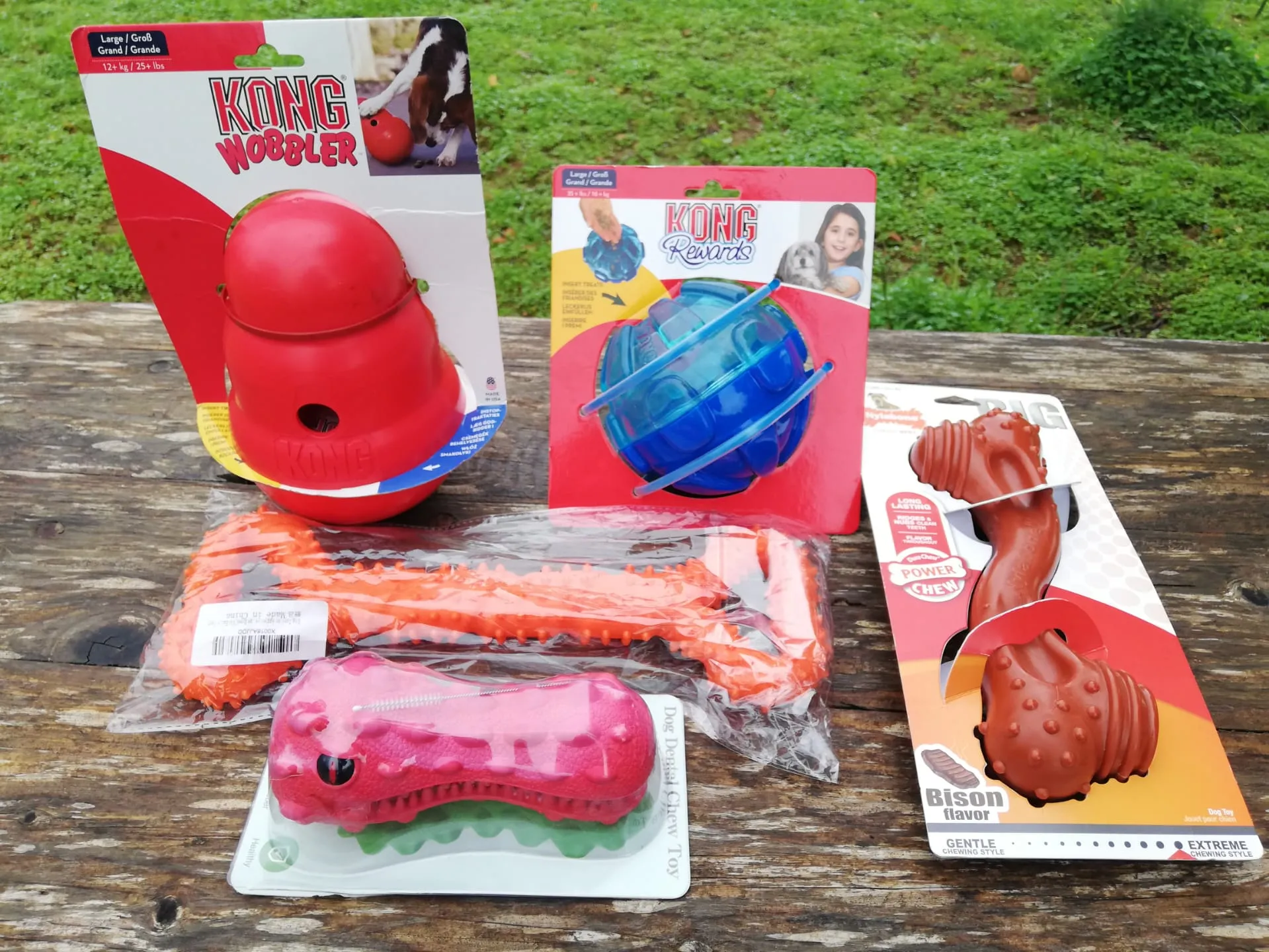 Benafim shelter dogs ready to test five indestructible toys
Benafim shelter dogs ready to test five indestructible toys
Nylabone Extreme Tough Dog Chew Toy
The Nylabone Extreme Tough Dog Chew Toy, an XXL Bison-flavored bone, arrived with a bold claim: “perfect for the most powerful of chewers and dogs above 23kg.” This immediately piqued our interest for our larger residents. Nero, a wise 9-year-old Pit Bull, dedicated hours to chewing this toy, leaving barely a mark. Despite its substantial size, it’s surprisingly light, making it easy for large dogs to carry. Its slightly curved design ensures an excellent grip for paws, enhancing the chewing experience.
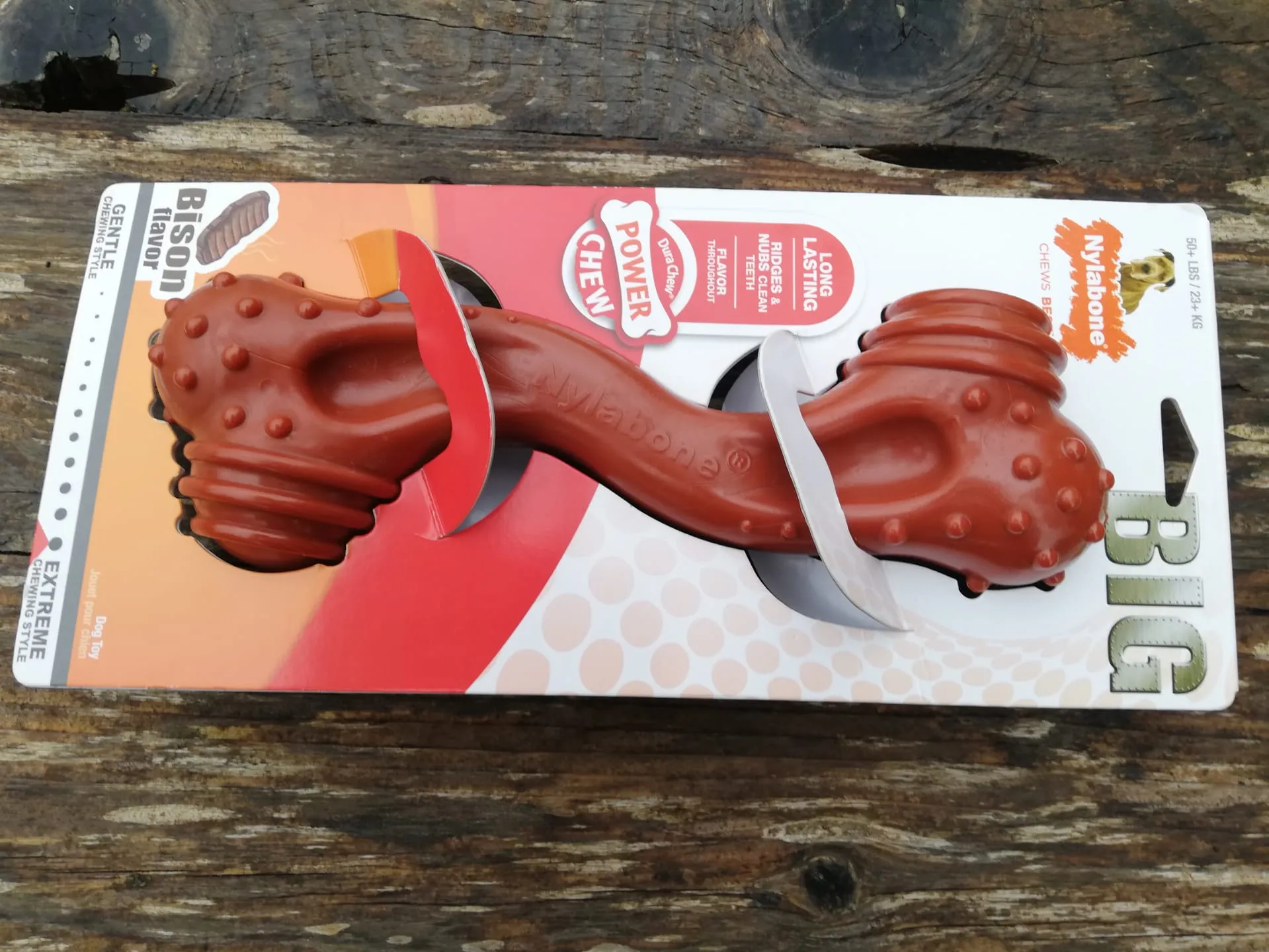 Nylabone Extreme Tough Dog Chew Toy with a price tag of £19.16
Nylabone Extreme Tough Dog Chew Toy with a price tag of £19.16
Maya, a 3-year-old who hadn’t experienced toys in her early life, was instantly drawn to the Nylabone. There were no confused looks; she immediately engaged with it, enjoying a good chew and running around, even encouraging Max to chase her. One of the standout features for us humans is its ease of cleaning and its perpetual flavor, which never diminishes. For owners who prioritize cleanliness, this bone is a dream—no mess, no lingering smells.
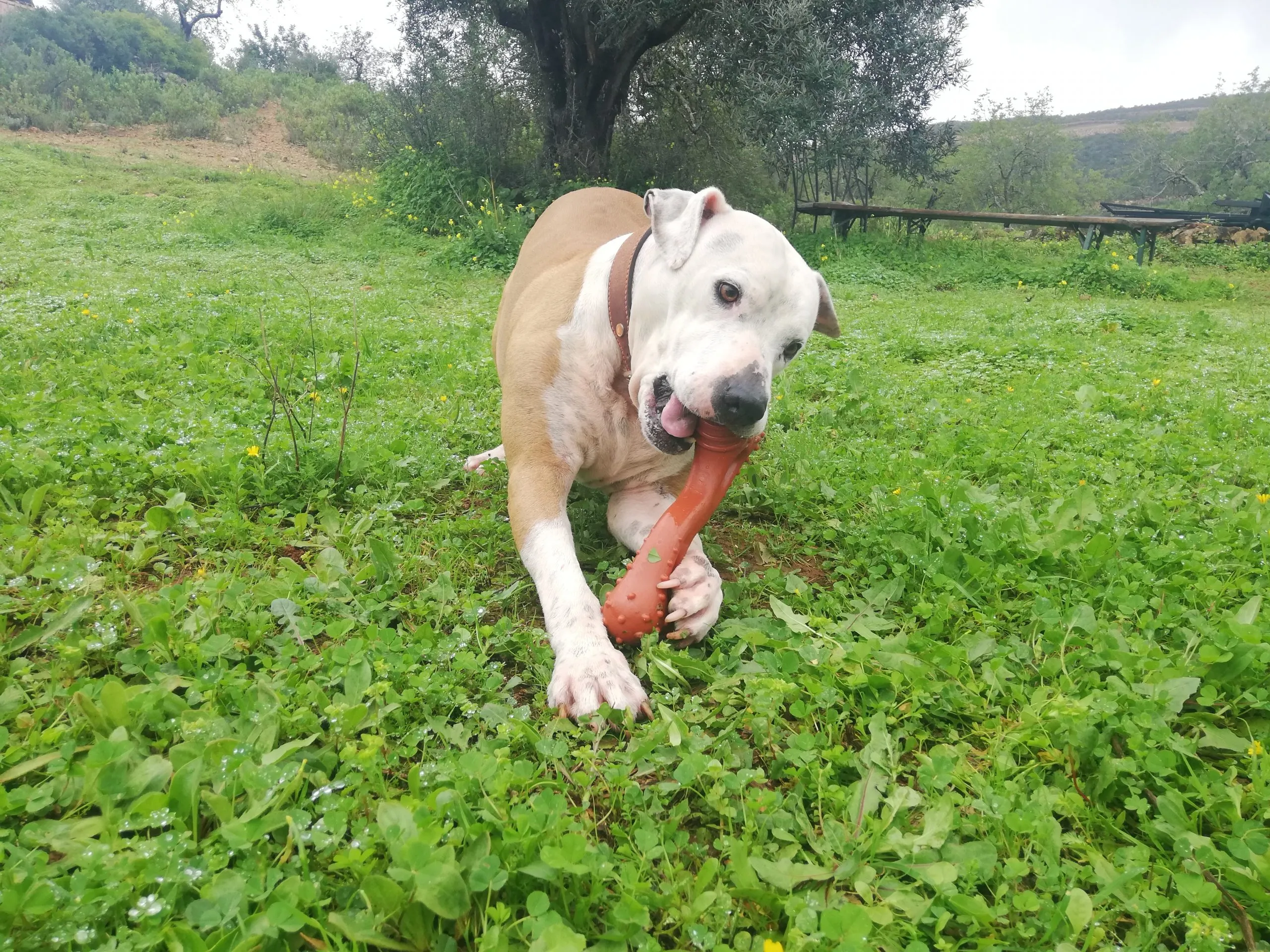 Nero, a white Pit Bull, actively testing the Bison-flavored Nylabone
Nero, a white Pit Bull, actively testing the Bison-flavored Nylabone
Black Nero, a Cane Corso cross known for his incredibly powerful chewing—capable of shredding a tree trunk as if it were cake—and his tendency to chew even strong fencing when anxious, met his match with this Nylabone. After hours of relentless chewing, there was hardly a tooth mark on the bone. This truly positions it as a top contender among the best chew toys for large dogs who are aggressive chewers.
The Details
- Flavor: Bison (also available in chicken and turkey), designed to encourage chewing.
- Dental Benefits: Raised nubs help clean teeth and gums.
- Safety: Safe and non-toxic.
- Measurements: 30.48 x 13.97 x 5.08 cm
- Weight: 485 grams
- Target Audience: Designed for dogs 23 kg (50 lbs) and above.
Summary
Every dog at the shelter enthusiastically recommends this Nylabone. If your large dog loves to chew, gets easily bored, and needs a tasty, durable toy to sink their teeth into, this is an excellent choice. It truly holds up to the “extreme tough” claim and is one of the best healthy chew toys for dogs that need a substantial challenge.
Kong Rewards Ball
The Kong Rewards Ball initially received a less enthusiastic welcome compared to other toys, but this reaction was short-lived. The clever concept of combining a bouncy toy with a treat dispenser quickly won over our canine reviewers. From a human perspective, inserting treats was simple, and unlike some other dispensers, our dogs didn’t need excessive brainpower to retrieve their rewards.
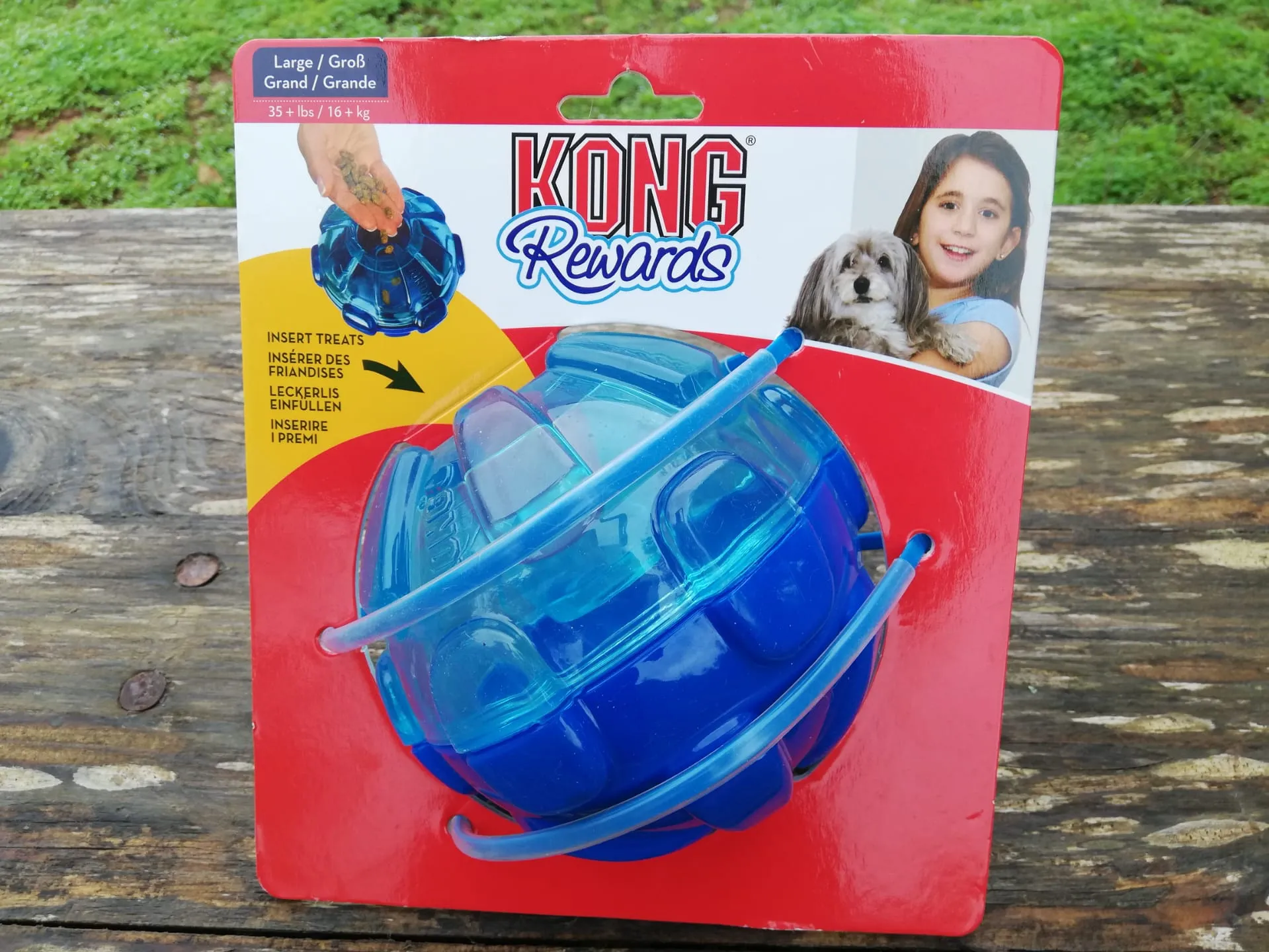 Kong Rewards Ball, priced at £9.99, being reviewed
Kong Rewards Ball, priced at £9.99, being reviewed
Interestingly, the dogs seemed to favor the soft, bouncy side of the ball more than the treat-dispensing aspect. Jean, in particular, absolutely adored this toy, repeatedly burying it and engaging in hours of chewing on its rubbery surface before rediscovering it. His best friend Komo barely got a look in, much to his dismay. This toy proved to be exceptionally durable, with not a single tooth mark found despite extensive play and chewing from dogs of all sizes at the shelter. The efficient treat dispenser ensured no treats were left inside, confirming its effectiveness.
The Details
- Measurements: 12.7 x 12.7 x 12.07 cm
- Weight: 417 Grams
- Target Audience: Designed for dogs 16 kg (35 lbs) and above.
Summary
The dogs agree that the Kong Rewards Ball is an excellent all-around toy, combining their favorite activities: play and food. It’s a durable and tough toy that withstands significant chewing, bouncing, and interactive play, while also serving as a simple and effective treat dispenser. For large dogs that enjoy interactive play and a mental challenge, this is a solid choice.
CyunCmay Indestructible Dog Toy XL Bone
The CyunCmay Indestructible Dog Toy XL Bone generated immense excitement upon unwrapping. However, this enthusiasm proved to be short-lived, especially once Black Nero got his powerful paws and teeth on it. While the dogs had a blast for about 30 minutes, enjoying tug-of-war with its end handles, a good chew, and fetching it from the lake, the toy ultimately failed to live up to its “indestructible” promise. If you are looking for extra tough chew toys for dogs, this one might not be it.
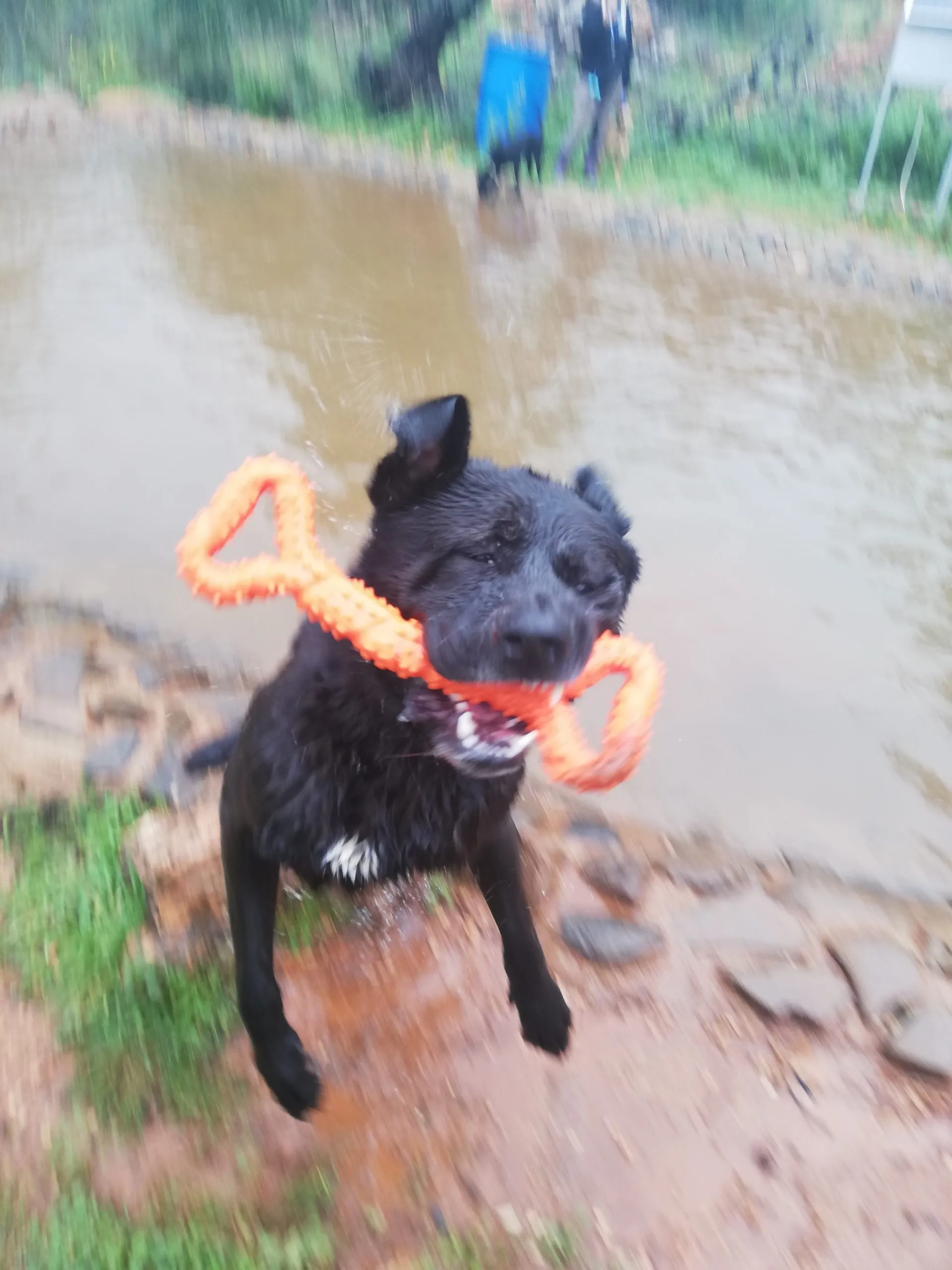 Black Nero in mid-air, thoroughly testing the CyunCmay toy
Black Nero in mid-air, thoroughly testing the CyunCmay toy
We had initial concerns about its soft, rubbery, and pliable material, fearing it wouldn’t withstand the extreme testing our dogs are known for. Sadly, Nero quickly proved us right. Within just 30 minutes, visible teeth marks appeared, and the bone was nearly split in two. This clearly indicates that for large, powerful chewers, this toy is not a suitable option if you’re seeking the best chew toys for large dogs that are truly durable.
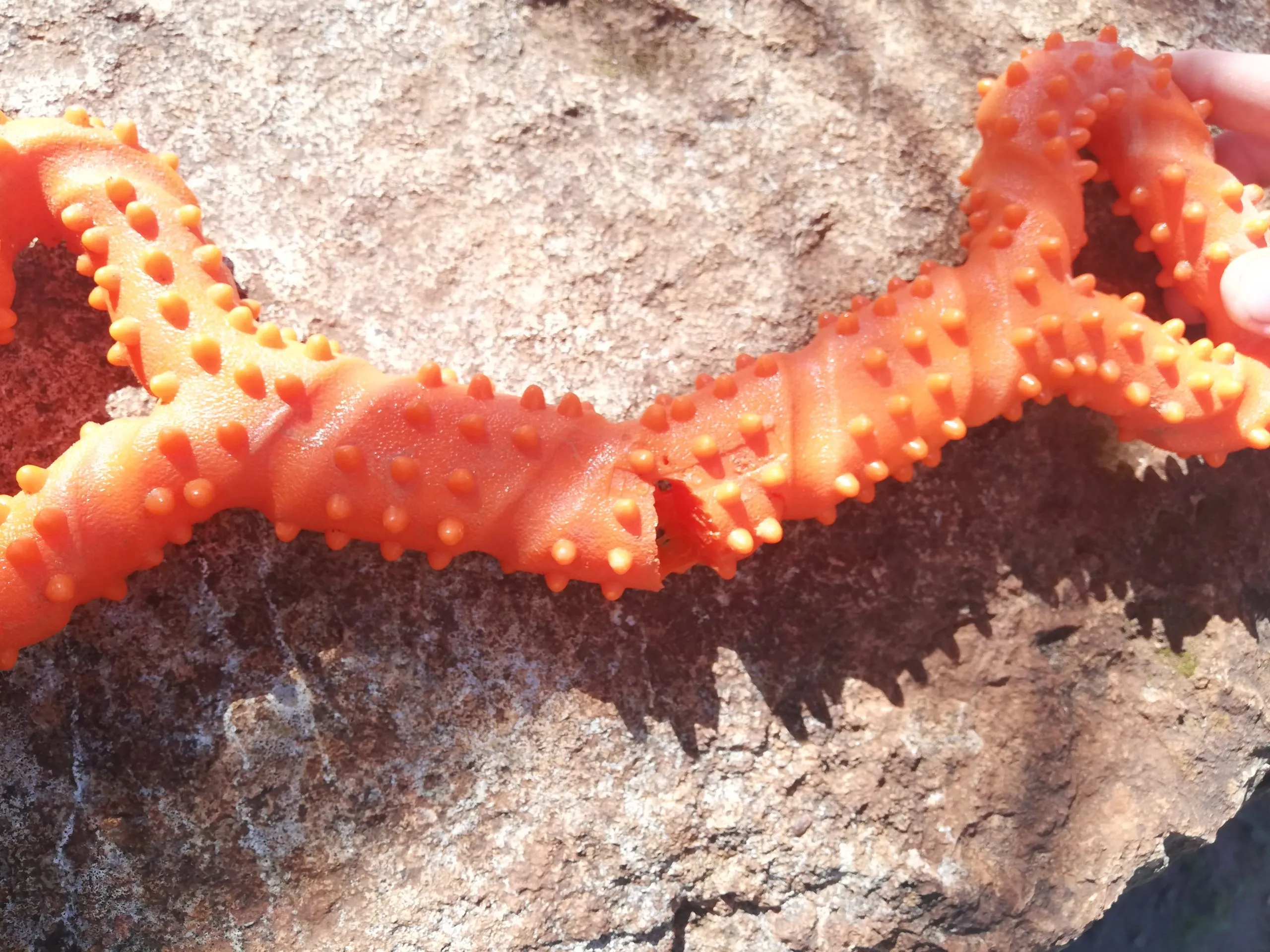 The CyunCmay XL bone showing teeth marks and nearly split in two after 30 minutes
The CyunCmay XL bone showing teeth marks and nearly split in two after 30 minutes
The Details
- Measurements: 32.9 x 12.2 x 3.8 cm
- Weight: 330 Grams
- Material: TPR environmentally friendly material, no chemical smell, safe and non-toxic.
- Dental Benefits: Surface designed to help clean a dog’s teeth and control plaque and tartar.
Summary
Despite being described as strong, durable, and suitable for medium to large dogs, our tests revealed otherwise. Is it indestructible? No. Is it fun for a short while? Yes. If your primary goal is a chew toy that won’t be destroyed in minutes by a large dog, this isn’t the one. However, if you’re looking for a fun toy for fetching that won’t be left unsupervised for chewing, it was popular for interactive play. Our dogs were visibly disappointed when the fun with this toy was so brief.
HETOO Indestructible Squeaky Dental Care Dog Toy
This HETOO toy, primarily designed for dental cleaning, was met with perplexing lack of enthusiasm from our expert reviewers. Even its squeak, usually a surefire way to grab a dog’s attention, failed to excite them. Maya, initially, even ran and hid at the strange noise emanating from the peculiar red object. She eventually mustered the courage to inspect it for a few moments.
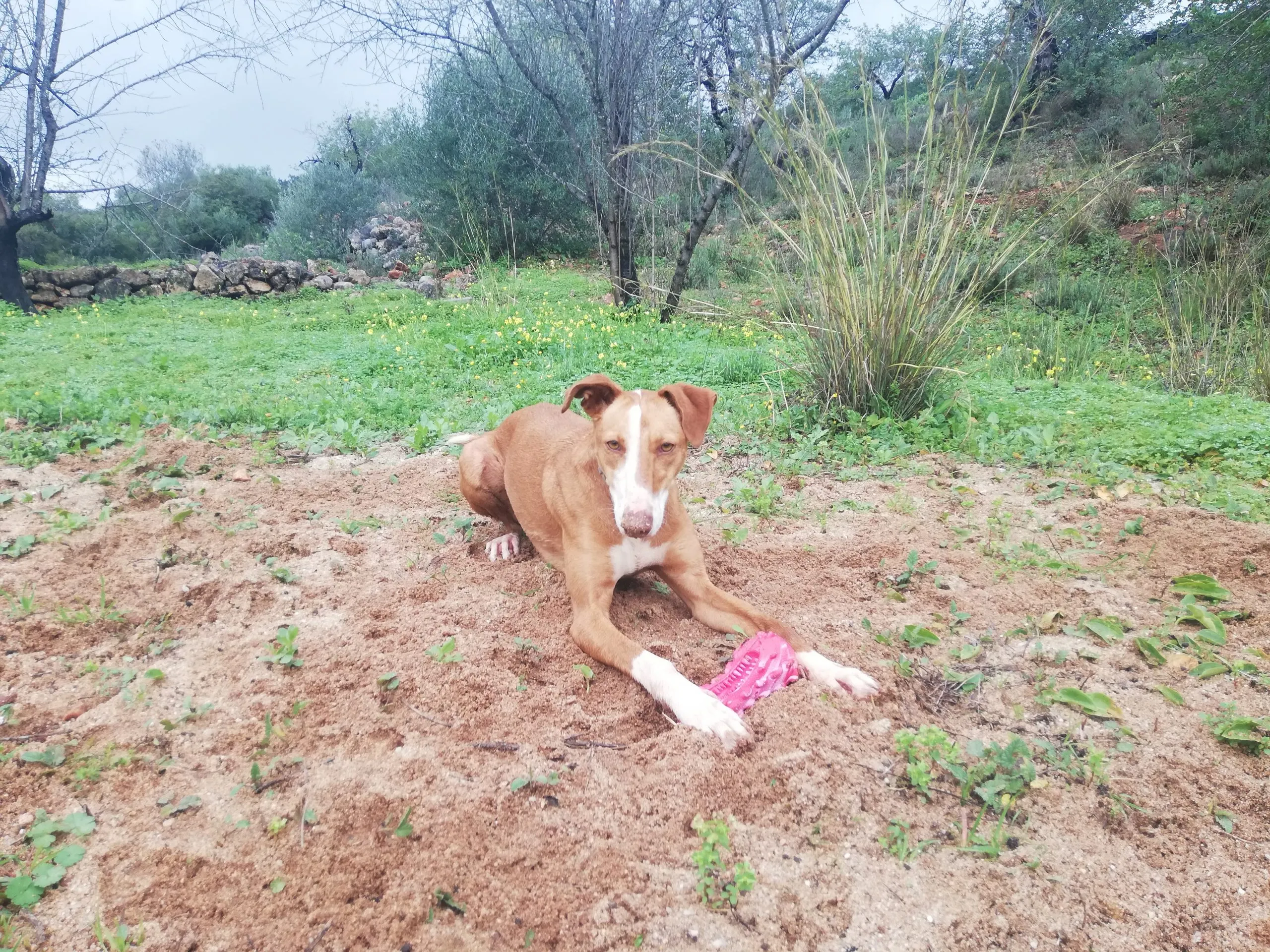 Maya, a brave shelter dog, carefully inspecting the Hetoo Toy during review
Maya, a brave shelter dog, carefully inspecting the Hetoo Toy during review
To make the toy more appealing, we smeared peanut butter into its grooves, hoping to encourage chewing. This tactic held Maya’s interest for a few minutes before she predictably wandered off, leaving the toy behind. Black Nero also showed brief, sporadic interest, but it was clear this toy struggled to engage our large dogs for any significant period, making it less ideal when considering the best dog chew toys for aggressive chewers or even just highly engaged players.
The Details
- Material: Natural rubber.
- Measurements: 12.7 x 12.7 x 12.07 cm
- Weight: 417 Grams
Summary
The Hetoo toy did not excite our dogs or keep them entertained for more than a few minutes. And yes, it squeaks—annoyingly so for us humans. Only Black Nero and Maya showed any interest, and even that was very short-lived. For large dogs seeking engaging and durable chew toys, this one falls short.
Kong Wobbler Interactive Treat Dispensing Dog Toy
The Kong Wobbler elicited hilarious reactions from our dogs. Was it a bird, a plane, a UFO? Its sheer size certainly contributed to the initial bewilderment. Unlike many other Kong treat toys, this one is made from a harder plastic polymer rather than rubber. From a human perspective, the twist-off lid makes filling it with treats exceptionally easy. Our canine experts, however, struggled initially. They wanted to play and understood treats were inside, but couldn’t quite figure out how to get them out.
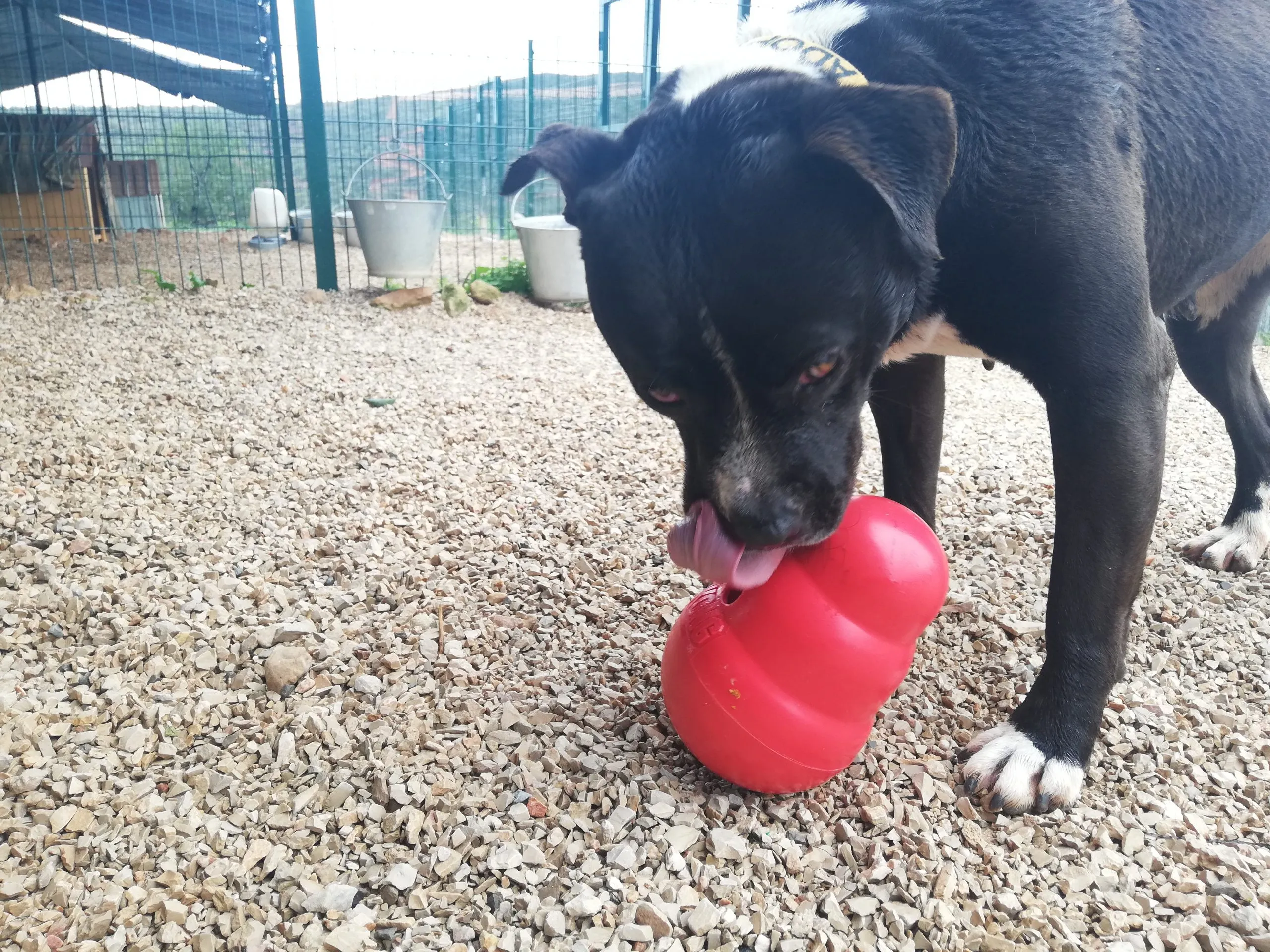 Pebbles intently focused on the Kong Wobbler, aiding in its review
Pebbles intently focused on the Kong Wobbler, aiding in its review
It dawned on us humans that the Kong Wobbler performs best on smooth surfaces, not the pebbly stone kennels, and that treat size needs to be compatible with the dispenser hole. Once these human errors were rectified, the toy became a huge hit. Its large size makes it challenging for dogs to pick up and carry in their mouths, which is actually a benefit as it reduces the chance of destructive chewing. This feature solidifies its position as one of the effective chew toys for large dogs that are designed to entertain without being destroyed. This type of interactive toy is also great for mental stimulation. Consider exploring dog rope toys for aggressive chewers uk if your dog needs a different kind of challenge.
The Details
- Material: Plastic polymer.
- Measurements: Diameter 13 x 19 cm
- Weight: 485 grams
- Target Audience: Designed for dogs 12 kg (26 lbs) and above.
- Capacity: Maximum filling capacity of 250 grams.
Summary
Once our dogs understood the Kong Wobbler and we humans adapted its use (correct surface, appropriate treat size), it was a resounding success. According to our dogs, it is indestructible and easy to use. It offers a great way to keep large dogs engaged and mentally stimulated, earning it a spot among the best chew toys for large dogs that are both durable and interactive.
Conclusion – Our Dog’s Verdict on the Best Chew Toys for Large Dogs
After extensive deliberation, numerous serious-looking meetings, and a chorus of barks, our shelter dogs have reached their final verdict on these five “indestructible” toys. When it comes to the best chew toys for large dogs, especially those with powerful jaws and high energy, a few clear winners emerged.
For the ultimate chewing challenge and unparalleled durability, the Nylabone Extreme Tough Dog Chew Toy stands out. It truly lived up to its claim, even with our most aggressive chewers like Black Nero, making it a top recommendation for any large dog needing a long-lasting, flavorful distraction.
When considering interactive play combined with durability, both the Kong Rewards Ball and the Kong Wobbler proved to be excellent choices. The Rewards Ball offers bouncy fun and easy treat dispensing, perfect for active dogs. The Wobbler, once understood by both dog and human, provides superb mental stimulation and treat rewards, proving to be practically indestructible and highly engaging for larger breeds.
Unfortunately, the CyunCmay Indestructible Dog Toy XL Bone and the Hetoo Indestructible Squeaky Dental Care Dog Toy did not meet the rigorous standards set by our large, active shelter dogs for sustained durability and engagement. While they offered fleeting moments of fun, they quickly succumbed to powerful chewing or failed to capture prolonged interest.
Choosing the right toy is crucial for a large dog’s dental health, mental stimulation, and overall happiness. Our rigorous testing confirms that while many toys claim to be “indestructible,” only a select few truly stand a chance against the formidable power of a large dog’s bite. Invest wisely, and your big dog will thank you with hours of contented chewing and play. For more insights on tough toys, check out our article on best dog chew toys for aggressive chewers.
